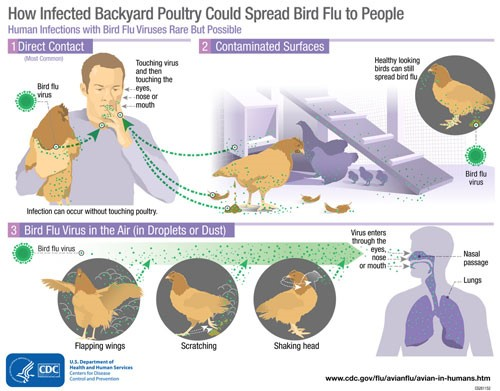

Context
China has recorded the first human infection with the H3N8 strain of bird flu.
About
What's happening?
- A four-year-old boy from central Henan province was found to have been infected with the variant after developing a fever and other symptoms.
- The H3N8 variant has previously been detected elsewhere in the world in horses, dogs, birds and seals but no human cases of H3N8 have been reported.
Why it matters?
- It's the first time the virus has jumped from animals to humans but it looks like a one-off jump and further risk of spread is low.
- Many different strains of bird flu are present in China and some sporadically infect people, usually those working with poultry.
- Last year China reported the first human case of H10N3.
Bird Flu:
- Bird flu, or avian flu, is an infectious type of influenza that spreads among birds. In rare cases, it can affect humans.
- There are lots of different strains of bird flu virus. Most of them don't infect humans. But there are 4 strains that have caused concern in recent years:
- H5N1 (since 1997)
- H7N9 (since 2013)
- H5N6 (since 2014)
- H5N8 (since 2016)

How bird flu spreads to humans?
- Bird flu is spread by close contact with an infected bird (dead or alive).
- This includes:
- touching infected birds
- touching droppings or bedding
- killing or preparing infected poultry for cooking
- Markets where live birds are sold can also be a source of bird flu.

Different types of avian influenza:
- Avian Influenza (AI) type A viruses are divided into subtypes based on two proteins on the surface of the virus:
- Hemagglutinin (HA), of which there are 16 subtypes (H1-H16)
- Neuraminidase (NA), of which there are 9 subtypes (N1-N9)
- Many combinations of HA and NA proteins are possible (i.e., H5N1, H5N2, H7N2, H7N8, etc).
- AI viruses are also classified into two groups based on their ability to produce disease in chickens: highly pathogenic avian influenza (HPAI) or low pathogenic avian influenza (LPAI).
- HPAI viruses cause high mortality in poultry and occasionally high death rates in certain species of wild birds.
- LPAI viruses can cause a variety of outcomes in poultry ranging from no apparent clinical signs to moderate death rates. LPAI viruses usually cause little to no signs in wild birds.
- H5 and H7 LPAI viruses have the potential to mutate or evolve into HPAI viruses and are closely monitored by animal health officials.



